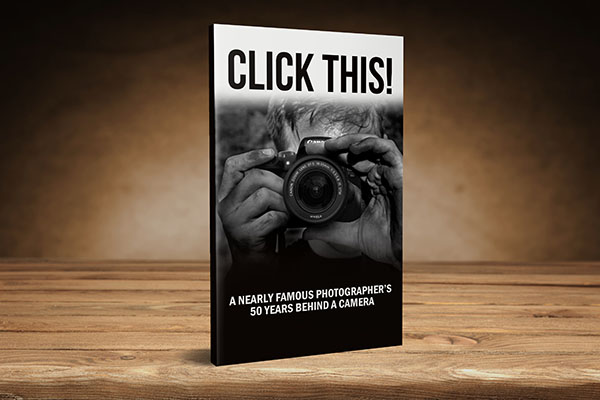JAMES ALTUCHER'S BOOK "SKIP THE LINE": NOTES FOR PHOTOGRAPHERS
EVERY PHOTOGRAPHER SHOULD READ THIS BOOK.Photo by Blaz Photo on Unsplash
JAMES ALTUCHER’S BOOK “SKIP THE LINE”: NOTES FOR PHOTOGRAPHERS
I am a big fan of James Altucher. I found his book “Choose Yourself” one afternoon and it changed my life. Few books have life-changing information, but “Choose Yourself” really registered with me. Big time.
When he announced this new book, I pre-ordered it on Amazon and when it came in I purchased the audio version at Audible.
 This book breaks down into simple and easy-to-understand methods you can apply to your own work and your own growth. It isn’t woo-woo ‘ideas’ and feel-good bullshit, this is real and doable tools to grasp and use.
This book breaks down into simple and easy-to-understand methods you can apply to your own work and your own growth. It isn’t woo-woo ‘ideas’ and feel-good bullshit, this is real and doable tools to grasp and use.
I believe every photographer should read this book as soon as they possibly can. It will help photographers see the changes happening around them in a far different light.
My quick summary of and the takeaways of each chapter.
THE ONE PERCENT RULE:
Incremental growth builds through compound. Trying something new sometimes means becoming better in small increments. Try to become a little bit better each day at whatever you are doing, or need to be doing.
For me, it is becoming more focused on my usage of time and the creation and production of assets.
More courses. More writing. More video. More photography.
EVERY DAY MATTERS
Each and every day, we must push the 1% rule. Skipping days, or slipping back is not allowed if we want to become better. Being serious about getting better, smarter, faster is an every single day venture. This is hard. The chaos of these crazy days means it is a bit more of a challenge to schedule consistently.
BORROW HOURS
Apply the skills from other endeavors to your new endeavor. I want to write more, so I am taking my blog writing skills and push them toward more publishing of long form books. I am a photographer, writer, and designer so I have skills in multiple areas that allow me to make and create books of many kinds.
If you have accounting skills, project management skills, or other business skills, they are part of the challenge that you need to meet to grow a photography business. Those skills are then integrated into your new business.
BUILD MICROSKILLS
Photography is more than simply making images. What other microskills do we need to be better at what we do?
Let’s say I want to start a photo business in my hometown. What are ten things that I must think about in order to grow faster?
Phone skills.
Marketing skills.
Writing skills.
Communication skills.
Design skills.
Organizational skills.
Research skills.
Producing skills.
Management skills.
Social skills.
Ten things that have nothing to do with photography, but everything to do with my ability to turn photography into a business.
We can break each one of those into microskills as well:
Phone skills:
Voice
Scripting
Dealing with objection
Getting to a sale
Being invited to show a book
Getting around the receptionist
And so forth.
PLUS MINUS EQUALS
Find a mentor and watch, listen, and learn.
Find a peer to work with and push (and be pushed) to success.
Find someone who wants you to mentor them.
There are always strata in any industry. Learning from someone who has done it, being involved with someone who is doing it, and helping someone who wants to do it keep us focused on all the success we are worthy of.
EXERCISE THE POSSIBILITY MUSCLE
OMISSION: If you do not try, you automatically fail.
COMMISSION: You try and fail to achieve what you needed to.
Omission is true failure… you never launched.
Commission is only partial failure because you learned what didn’t work. And you may have found something that did work in the process of the fail.
When you begin the next project (photograph, portfolio, assignment, personal project) you will be far more prepared to execute properly because of the knowledge you gained.
FIND THE CONSPIRACY NUMBER
How many things must be considered to conspire to get you to a point where success is possible?
Create a new portfolio for lifestyle:
- Talent, models, people.
- Makeup artists.
- Stylists.
- Access to wardrobe.
- Access to locations.
- Access to props.
- Finding time to shoot where everybody can be there.
- Weather.
- Food for participants.
- Distance of participants from each other and the shoot site.
- The “Show Up” failure rate of non-professionals.
- Fees for professionals.
In other words, putting together a lifestyle shoot is fraught with challenges. This is NOT to mean you should not do it. It means that you need to consider all who must conspire to make this happen.
Create a new portfolio of still life:
- An idea for binding the images together (style, type, era, whatever).
- Props to shoot.
- A place to shoot them.
- Time to shoot them.
As we can see, far fewer conspirators must be assembled for the still life shoot than that of the lifestyle shoot.
When you are building your business and your portfolio, KNOWING the conspiracy number is a very valuable insight.
GIVE PEOPLE THE POWER TO DECIDE
Give those around you the power to decide instead of telling them exactly what to do. Input from those other voices can be very useful.
Ask your client what they would expect to pay.
Ask your landlord what they would expect the rent increase to be.
Ask your spouse or partner what their expectations of your time are.
People are far more interested in you when you ask for their advice instead of telling them what to expect.
EXIT THE LINE
Modern life is about standing in ques. We wait in line for everything.
Stop waiting in line and make a move to the end zone. Of course you must KNOW what that endzone is and here are three questions to ask.
As with anything, being honest is more important than being “right”.
- Will this change improve my relationship with others?
- Will it improve my mastery of something I love?
- Will it increase my freedom and my ability to take more control of my personal life?
These are yes and no questions, and you can see where a no on any of them will be problematic. But you can also see that you will have to ask this set of questions at many junctures along the way as you make your exit.
I hate waiting in line.
And I skip it whenever possible.
BECOMING AN ENTREPRENEUR
Or at least think like one. This is taking the most responsibility for where you are than simply being a cog in a wheel.
TAKE BABY STEPS
Explore what you want to do as a “Side Hustle”. If you are financially in no condition to skip as far up the line as you want, try doing it as professionally as possible in your down time. You may have to give up some “Netflix binging” but in the end it is worth it. Think of it as a tiny experiment.
DIVERSIFY
Use time and assets as wisely as possible. Expand your horizons as much as possible. Find more channels to make money.
Write / create a photo book.
Create a photography course.
Sell merchandise on an affiliate photo website.
Sell prints.
Shoot for online stores.
TAKE BACK YOUR TIME
Stop wasting time. You know what I’m talking about.
THE ACCESS ECONOMY MODEL
You have excess, someone wants access.
Ryan in Colorado has an excess of knowledge about the mountains and valleys of the Western Slope of Colorado. Photographers in Chicago will pay for the access to his knowledge.
Result: Create workshop/photo tours.
You have an excess knowledge of how to shoot product that helps the buyer make their choice. People who make products want access to that knowledge… but you may have to explain it a bit before they understand what they need.
Result: Create a seminar for small business manufacturing that shows them WHY they should choose you. Alternate: Brochure, website, email.
Amy has an email list of 2100 small businesses that she sends to regularly. She has the excess, you want the access. Work with Amy to find a way to get your service into her newsletter.
THE GOD – HUMANS – DATA MODEL
Technology disrupts everything it touches. And that disruption can displace. Find the gaps between and interesting things can emerge.
When digital appeared, entire companies were created to make card holders, screen protectors, data storage, and more. Where film once was, other tech businesses filled the gaps.
THE BOTTOM ONE-THIRD MODEL
Everyone wants the top of the line. Smart money is made at the bottom as well.
Damned hard to get into a big ad agency.
Very hard to get into national magazines.
Hard to get into a big design agency.
Challenging to get into a local or regional magazine art department.
Somewhat challenging to get into smaller local and regional design firms.
Less challenging to get into corporate art departments/
Easier to get into small businesses.
If we could see the numbers spent on marketing we would find that ad agencies are the top third, national magazines, large design firms holding onto the middle third, and local magazines, corporate art departments, and small businesses at the bottom third.
The numbers would be somewhat inverted when it comes to the number of clients at each level.
Few big ad agencies and national magazines.
Far more big design firms.
Far, far more regional magazines, corporate art departments, local designers, and small businesses.
Get familiar with the business at the bottom as you make inroads into the higher realms.
Focus on the base to build the ladder up.
WHAT MAKES A GOOD STORY
If you own the narrative, you own the imaginations and interests of the people you are hoping to engage with.
Can you craft a good story about what you do? Can you provide a touchstone for customers to identify with as you create your ‘brand’? It is important to spend a lot of time on this – as much as you need to in order to make your story one that has others engaged.
We live and work in a business that is all about helping others engage their audiences. We need to take the same tact in our own.
ADDENDUM:
I found the 80/20 breakdown totally fascinating.
If 20% of what I do gets me 80% results, that is good data. However, we can apply that 80/20 to the 80/20 itself.
20% of 20% is right around 5 and change. 80% of 80% is about 65%.
So 6% of what I do is bringing in 65% of my results.
Wow… data.
But if we do it one more time we find that 20% of 6 is a bit over 1% and 80% of 65% is about 50%.
ONE PERCENT OF WHAT I DO IS BRINGING ME FIFTY PERCENT RETURN?!?!
Valuable and actionable data, and something that blows my mind.
What to do becomes a whole new chapter into personal research and self-awareness.
10 + Rules for Living a Good Life
- Always go to the place least crowded. Success is found where nobody else is.
- Being secretly good to people = superhero. Being famous for the sake of being famous = loser.
- Good relationships = good life. Bad relationships = bad life.
- If you do what you’ve always done, you’ll get what you’ve always gotten.
- Sleep and rest.
- Bad things will happen. Treat them like opportunities
- Don’t feel sorry for yourself ever. See above.
- Be creative every day.
- Live life as if today might be your last day.
- Hara hachi bun me, which means “eat 80 percent of your capacity.” Because people only realize they are full about twenty minutes after they are full.
- READ!
- Buy convenience.
- Don’t read the news.
- Everything worthwhile requires skill.
- If someone doesn’t like you, then ignore them.
- Don’t believe something just because everyone else believes it.
- Don’t outsource self-esteem.
- Facts are irrelevant. Facts aren’t as useful as possibilities.
- There’s always a good reason and a real reason. When someone gives you a good reason, a reason that is impossible to argue with, it might be true and important. But always ask what the real reason is. There is always a real reason.
Here is James’ own review of his book.
And again, it is available on Amazon. I suggest you get a copy. Or two.
SEEKING THE “PERFECT” IMAGE MAY BE COUNTER PRODUCTIVE
Sometimes we get focused on the things we think will make us better and ignore the simple things that will indeed make us better. Recently I wrote about not taking enough photographs, now I will take on the idea of the ‘perfect’ image… or exposure or composition....
POLAROID PORTRAITS AROUND 1985
Back in the mid ’80s, I was shooting a lot of fashion and beauty work in my Phoenix studio, and occasionally in New York and Chicago. Those were heady times with shoot schedules coming back to back for weeks and months at a time. My work at the time was mostly focused...
SO YOU’RE A PROFESSIONAL PHOTOGRAPHER… WHY SHOULD ANYONE HIRE YOU?
“Why should I hire you to shoot this job for us?” This is one of the most challenging questions you will ever get. It happened to me once and I had no answer. None. My brain simply stopped doing anything as I sat there wondering what in the hell I was supposed to say?...
BLACK FRIDAY
THE ANNUAL BLACK FRIDAY EVENT RECORDINGS NOW AVAILABLE I have been doing this for several years. My Black Friday stuff is always free, always entertaining, always informative. Everybody else wants your money, I only want you to be better at what you do. THIS YEAR'S...
IT’S TOUGH TO QUIT THAT 9-5… BUT HERE’S A ROADMAP
Can’t figure a way of that nine to five? Here’s an idea or two. One of the hardest things to do when making that transition from full-time worker to self-employed creative is to know when to make that jump. Even HOW to make that jump seems almost an impossible to...
2021: MOTORCYCLE ROADTRIP 2021
The funny thing about motorcycle rides is how much time we put into planning them. We plan our routes, our side trips, our downtime. We pour over maps and look for twisty roads, then check them closely to see if they are paved. We plan our planning even. We set aside...






